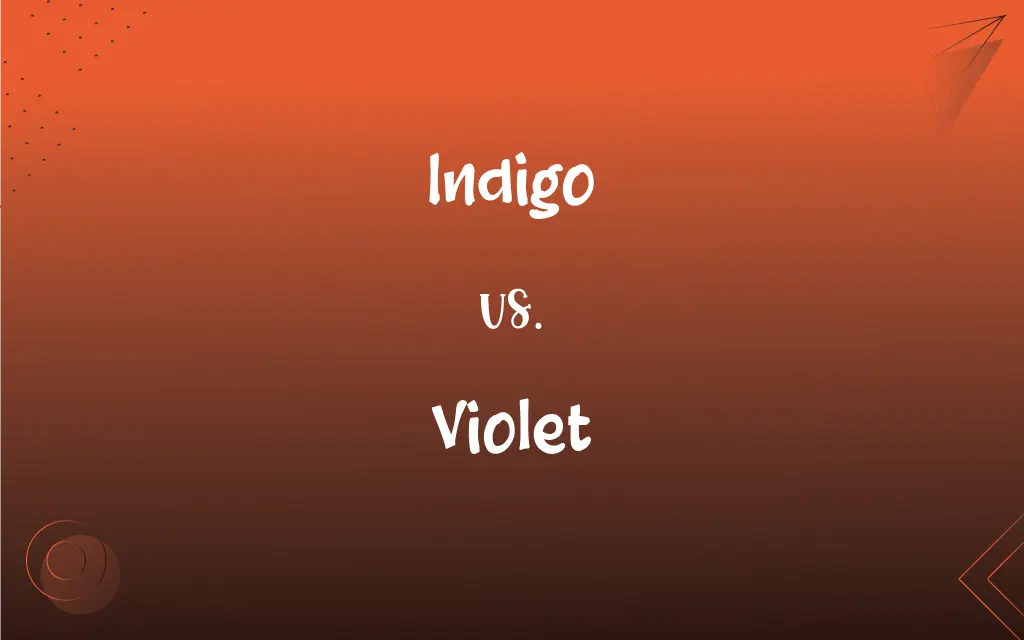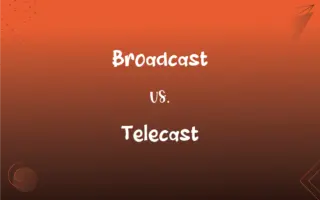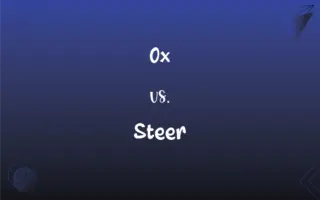Indigo vs. Violet: What's the Difference?
Edited by Harlon Moss || By Janet White || Updated on October 2, 2023
Indigo is a deep blue-purple color, while violet is a bright purplish-blue color, both occupying different positions in the spectrum of light.

Key Differences
Indigo and violet are both colors that find their place in the rainbow and the spectrum of visible light. Indigo leans more towards a deep blue with a hint of purple. Historically, it has been associated with the dye derived from the plant of the same name. When one thinks of indigo, the associations might be with deep, rich hues reminiscent of a night sky. Violet, on the other hand, is a more vibrant color that edges closer to purple but retains a distinct blueness. It is often considered a more lively and bright hue compared to the depth of indigo.
In the context of the spectrum of visible light, indigo and violet sit close but are distinct. Sir Isaac Newton introduced the term "indigo" as one of the seven colors in the spectrum. Indigo, in this context, exists between blue and violet. Violet, meanwhile, is at the end of the spectrum and is the color with the shortest wavelength of visible light.
From a cultural standpoint, both indigo and violet have significant meanings. Indigo is often associated with intuition, perception, and the higher mind in various spiritual contexts. It's believed to inspire deep concentration during times of introspection and meditation. Violet, being close to purple, is frequently linked with royalty, luxury, and power. Moreover, violet can also symbolize mystery, magic, and deep spirituality.
Both colors have their own aesthetic appeal and are used in various artistic endeavors. Indigo's rich depth makes it a favorite for fashion, especially in denim and other fabrics. Violet, with its bright allure, often graces artworks, floral arrangements, and other decorative aspects. Both indigo and violet, with their distinct shades and meanings, add depth and variety to the world of colors.
Comparison Chart
Position in Spectrum
Between blue and violet
At the end of the spectrum, after indigo
ADVERTISEMENT
Tone
Deep blue with a hint of purple
Bright purplish-blue
Historical Use
Associated with dye from the indigo plant
Often associated with royalty and spirituality
Cultural Significance
Intuition, perception, higher mind
Royalty, luxury, mystery, magic
Common Uses
Denim, fabrics
Artworks, floral arrangements
Indigo and Violet Definitions
Indigo
Pertaining to a hue between blue and violet in the spectrum.
The artist used indigo for the night sky in his painting.
ADVERTISEMENT
Violet
Relating to the shortest wavelength of visible light.
Violet rays are at the end of the visible spectrum.
Indigo
A dye obtained from the indigo plant.
The fabric was dyed using natural indigo.
Violet
Symbolic of royalty, luxury, and spirituality.
The queen wore a crown adorned with violet gems.
Indigo
Symbolic of depth, intuition, and perception.
The room's indigo walls evoked a sense of calm and introspection.
Violet
Evocative of mystery, magic, and deep spirituality.
The story described a forest bathed in violet light where magic was real.
Indigo
A deep blue-purple color.
She wore an indigo dress to the evening gala.
Violet
Any of various low-growing herbs of the genus Viola, having short-spurred, irregular flowers that are characteristically purplish-blue but sometimes yellow or white.
Indigo
Any of various shrubs or herbs of the genus Indigofera in the pea family, having pinnately compound leaves and usually red or purple flowers in axillary racemes.
Violet
Any of several similar plants, such as an African violet.
Indigo
A dark blue crystalline compound, C16H10N2O2, that is obtained from these plants or produced synthetically and is widely used as a textile dye. Also called indigotin.
Violet
The hue at the short-wavelength end of the visible spectrum, evoked in the human observer by radiant energy with wavelengths of approximately 380 to 420 nanometers; any of a group of colors, reddish-blue in hue, that may vary in lightness and saturation.
Indigo
Any of several related plants, especially those of the genera Amorpha and Baptisia.
Violet
A plant or flower of the genus Viola, especially the fragrant Viola odorata; (inexact) similar-looking plants and flowers.
Indigo
The hue of that portion of the visible spectrum lying between blue and violet, evoked in the human observer by radiant energy with wavelengths of approximately 420 to 450 nanometers; a dark blue to grayish purple blue.
Violet
(figurative) A person thought to resemble V. odorata, especially in its beauty and delicacy.
Indigo
A purplish-blue colour
Violet
A bluish-purple colour resembling that of most V. odorata.
Indigo
An indigo-colored dye obtained from certain plants (the indigo plant or woad), or a similar synthetic dye.
Violet
Clothes and (ecclesiastical) vestments of such a colour.
Indigo
An indigo plant, such as from species in genera Indigofera, Amorpha (false indigo), Baptisia (wild indigo), and Psorothamnus and Dalea (indigo bush).
Violet
(perfumes) The characteristic scent of V. odorata.
Indigo
Having a deep purplish-blue colour
Violet
Syn of onion.
Indigo
A kind of deep blue, one of the seven prismatic colors.
Violet
Having a bluish-purple colour.
Indigo
A blue dyestuff obtained from several plants belonging to very different genera and orders, such as, the woad, Isatis tinctoria (family Cruciferae), Indigofera suffroticosa, Indigofera tinctoria (family Leguminosae), Indigofera Anil, Nereum tinctorium, Polygonum tinctorium Ait. (family Polygonaceae), etc.; called also natural indigo. It is a dark blue earthy substance, tasteless and odorless, with a copper-violet luster when rubbed. Indigo does not exist in the plants as such, but is obtained by decomposition of the glycoside indican.
Violet
Any plant or flower of the genus Viola, of many species. The violets are generally low, herbaceous plants, and the flowers of many of the species are blue, while others are white or yellow, or of several colors, as the pansy (Viola tricolor).
Indigo
Having the color of, pertaining to, or derived from, indigo.
Violet
The color of a violet, or that part of the spectrum farthest from red. It is the most refrangible part of the spectrum.
Indigo
A blue dye obtained from plants or made synthetically
Violet
In art, a color produced by a combination of red and blue in equal proportions; a bluish purple color.
Indigo
Deciduous subshrub of southeastern Asia having pinnate leaves and clusters of red or purple flowers; a source of indigo dye
Violet
Any one of numerous species of small violet-colored butterflies belonging to Lycæna, or Rusticus, and allied genera.
Indigo
A blue-violet color
Violet
Dark blue, inclining to red; bluish purple; having a color produced by red and blue combined.
Indigo
Of or related to the indigo plant.
Indigo leaves were spread out to dry in the sun.
Violet
Any of numerous low-growing small-flowered violas
Violet
A variable color that lies beyond blue in the spectrum
Violet
Of a color midway between red and blue
Violet
A bright purplish-blue color.
She picked a bouquet of violet flowers.
Violet
A plant or flower of a genus Viola.
Violets bloomed in her garden every spring.
FAQs
What is indigo?
Indigo is a deep blue-purple color and is also a dye derived from the plant of the same name.
Is indigo closer to blue or purple?
Indigo leans more towards blue with a hint of purple.
How is violet different from indigo?
Violet is a bright purplish-blue color, positioned at the end of the visible light spectrum.
Why is violet associated with royalty?
Historically, violet dyes were expensive, making them accessible mainly to the elite and royalty.
How is indigo used in fashion?
Indigo is a popular color for denim and various fabrics.
Is violet a primary or secondary color?
Violet is not a primary color but can be considered a secondary or tertiary color in different color models.
Where do indigo and violet sit in the spectrum?
Indigo is between blue and violet, while violet is at the end of the spectrum.
What's the significance of indigo in spirituality?
Indigo is often linked with intuition, perception, and the higher mind.
What are the cultural connotations of violet?
Violet often symbolizes royalty, luxury, mystery, and spirituality.
Which has a shorter wavelength, indigo or violet?
Violet has the shortest wavelength of visible light.
Can indigo and violet be used interchangeably in art?
While both are shades of blue-purple, their distinct hues serve different artistic purposes.
How do you make the color indigo in art?
Indigo can be achieved by mixing blue and purple, leaning more towards blue.
Why is indigo included in the rainbow?
Sir Isaac Newton introduced indigo as one of the seven spectrum colors, though its distinction is sometimes debated.
What flowers are typically violet?
The violet flower, from the genus Viola, is a typical example.
Is violet light harmful?
Violet, or ultraviolet light, has shorter wavelengths and can be harmful in prolonged exposures.
Where does the name "violet" originate?
It comes from the Latin name for the flower, "viola."
Are indigo and violet easily distinguishable to the human eye?
While distinct, some people might find them hard to differentiate due to the closeness in the spectrum.
Why is indigo considered a color of depth?
Its deep blue-purple hue evokes feelings of vastness, akin to a night sky or deep waters.
Is indigo a natural dye?
Yes, indigo is derived from the plant of the same name.
What feelings might indigo evoke?
Indigo can inspire feelings of depth, introspection, and calm.
About Author
Written by
Janet WhiteJanet White has been an esteemed writer and blogger for Difference Wiki. Holding a Master's degree in Science and Medical Journalism from the prestigious Boston University, she has consistently demonstrated her expertise and passion for her field. When she's not immersed in her work, Janet relishes her time exercising, delving into a good book, and cherishing moments with friends and family.
Edited by
Harlon MossHarlon is a seasoned quality moderator and accomplished content writer for Difference Wiki. An alumnus of the prestigious University of California, he earned his degree in Computer Science. Leveraging his academic background, Harlon brings a meticulous and informed perspective to his work, ensuring content accuracy and excellence.
































































